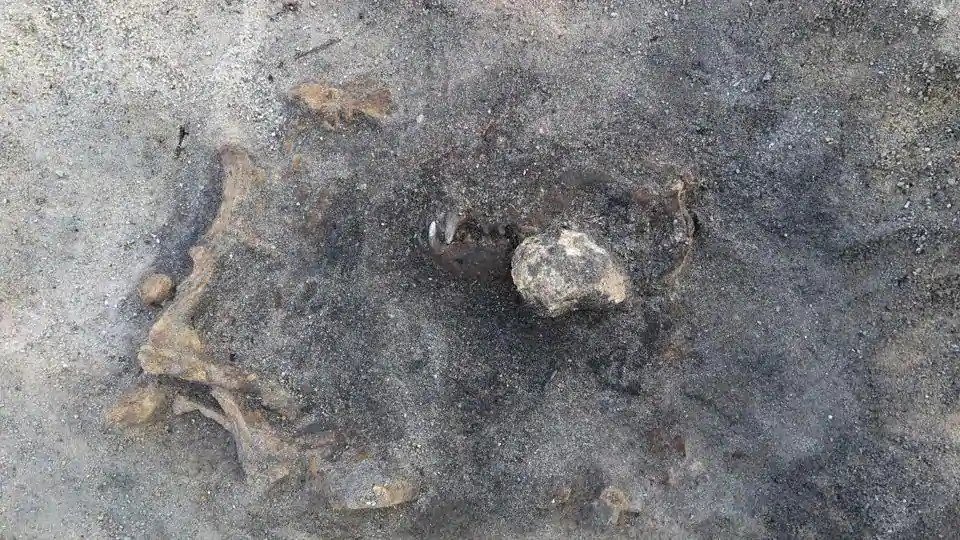8,400 years old Dog Remain found at Stone Age burial site in Sweden
The uncovered ancient dog is still over 8400 years old at the grave ground of the Stone Age city in Sweden. The canine was buried with remains of individuals, who were part of a traditional custom called ‘grave goods,’ the living would leave valuables or sentimental objects with the dead.
The bones were studied by an animal osteologist but there was no modern dog like that, who said it was ‘like a powerful greyhound. Originally established close to the ocean, the settlement was covered by rising sea levels that layered sand and mud over the remains that kept the artifacts preserved for thousands of years.
The location where the dog was discovered is part of an extensive site where municipal authorities and archaeologists perform one of the biggest archaeological digs ever in the city.

The settlement is located in what is now Ljungaviken in Sölvesborg and has been a prime site for archaeologists since 2015. During the excavation, the team has found evidence of at least 56 structures that once stood at the site, along with postholes and pits.
The dog bones are a new discovery and have not been removed from the ground yet but archaeologists plan to eventually take them to the Blekinge Museum for study.
Osteologist Ola Magnell of the Blekinge Museum said of the discovery near the town of Solvesborg, said: ‘The dog is well preserved, and the fact that it is buried in the middle of the Stone Age settlement is unique,’
Museum project manager Carl Persson said ‘a sudden and violent increase of the sea level’ flooded the area with mud that had helped preserve the burial site. An ongoing archaeological excavation has involved removing layers of sand and mud.
The Swedish archaeologists said the dog was buried with a person, noting that survivors often leave valuable or sentimental objects with the dead. Such findings ‘makes you feel even closer to the people who lived here,’ Persson said in a statement.


A buried dog somehow shows how similar we are over the millennia when it comes to feelings like grief and loss.’ The area is believed to have been inhabited by hunters during the Stone Age. A residential community is expected to be built on the burial site once the archaeologists are done.
Dogs seem to have been man’s best friend for thousands of years, as archaeologists are uncovering remains all over the world that suggest they were domesticated pets.
Earlier this month, a team discovered what they believe could be the oldest ever remains of a pet dog. Experts suspected the remains are between 14,000 and 20,000 years old, spanning back to the very dawn of the special relationship between humans and canines.
Researchers from the University of Siena in Italy hope their discovery can shed light on how dogs made the change from wild carnivores to loving companions.
One theory is that wolves became scavengers out of necessity due to a lack of food, and this took them close to human settlements. Some experts believe the animals and humans slowly developed a bond and the symbiotic relationship flourished from there.
Others think wolves and humans worked together when hunting and this is how the relationship spawned. The research team from Siena University hopes that the surviving fragments of one of the first dogs to live alongside humans as a pet could help find a definitive answer.
Dr. Francesco Boschin led a piece of research, published in August in Scientific Reports, on early canine remains found at two paleolithic caves in Southern Italy, the Paglicci Cave, and the Romanelli Cave.
Writing in this study, the scientists say: ‘Our combined molecular and morphological analyses of fossil canid remain from the sites of Grotta Paglicci and Grotta Romanelli, in southern Italy, attest of the presence of dogs at least 14,000 calibrated years before present.
‘This unambiguously documents one of the earliest occurrences of domesticates in the Upper Palaeolithic of Europe and in the Mediterranean.’

However, a further analysis which is still ongoing shows this figure could indeed be much later, towards 20,000 years, Dr. Boschin told RealPress.
From an archaeological point of view, the oldest remains of domesticated dogs were found in Central Europe and date back 16,000 years,’ Boschin said.
‘In the Mediterranean area we have now established that domesticated dogs lived here 14,000 years ago for sure, but possibly even 20,000 years ago
